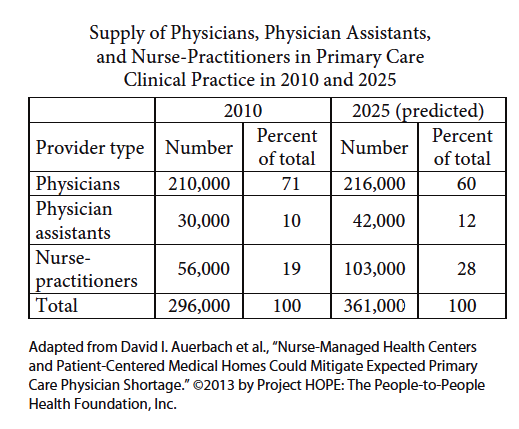The Physician Assistant Will See You Now
23 The term “paramedics” refers to health care workers who provide routine and clinical services.–––––––––––––––––––––––––––––––––––––––––––––––––––––––––––––––––––––––––––––––––––––––––––––––––––––– While the pressures of an aging population, insurance reforms, and health epidemics have increased demand for care, the supply of physicians is not expected to 24 keep pace.––––––––––– The Association of American Medical Colleges predicts a shortage of over 90,000 physicians by 2020, by 2025, that number could climb to more than 130,000. In some parts of the country, shortages are already a sad fact of life. A 2009 report by the Bureau of Health Professions notes that although a fifth of the US population lives in rural areas, less than a tenth of US physicians serves that population. Because a traditionalist response to the crisis— 25 amping up–––––––––––– medical-college enrollments and expanding physician training programs—is too slow and costly to address the near-term problem, alternatives are being explored. One promising avenue has been greater reliance on physician assistants (PAs).
26 By virtue of 27 there–––––– medical training, PAs can perform many of the jobs traditionally done by doctors, including treating chronic and acute conditions, performing minor 28 surgeries: and––––––––––––––– prescribing some medications. However, although well 29 compensated earning in 2012 a median annual salary of $90,930,––––––––––––––––––––––––––––––––––––––––––––––––––––––––––––––––––––– PAs cost health care providers less than do the physicians who might otherwise undertake these tasks. Moreover, the training period for PAs is markedly shorter than 30 those for–––––––––– physicians—two to three years versus the seven to eleven required for physicians.
Physician assistants already offer vital primary care in many locations. Some 90,000 PAs were employed nationwide in 2012. Over and above their value in partially compensating for the general physician shortage has been their extraordinary contribution to rural health care. A recent review of the scholarly literature by Texas researchers found that PAs lend cost-efficient, widely appreciated services in underserved areas. 31 In addition,––––––––––––– rural-based PAs often provide a broader spectrum of such services than do their urban and suburban counterparts, possibly as a consequence of the limited pool of rural-based physicians.
Increasingly, PAs and other such medical practitioners have become a critical complement to physicians. A 2013 RAND Corporation report estimates that while the number of primary care physicians will increase slowly from 2010 to 2025, the number of physician assistants and nurse-practitioners in primary care will grow at much faster rates. 32 Both by merit and from necessity, PAs are likely to greet more 33 patience than––––––––––––––– ever before.

NO CHANGE
maintain the tempo.
get in line.
move along.
The correct Answer is:A
Because “keep pace” is an appropriate idiomatic expression that clearly indicates the writer’s concern that the supply of doctors won’t be able to match the growing demand for them.
Choices B, C, and D are incorrect because they are unidiomatic in the context of the sentence. The sentence discusses the mismatch between the “increased demand for care” and the limited “supply of physicians.” The writer is concerned with the extent to which supply can grow to meet the growth in demand—or, in other words, “keep pace” with increased demand. The phrases “maintain the tempo,” “get in line,” and “move along” are inappropriate to convey this idea.
Similar Questions
क आयत का क्षेत्रफल समान रहता है यदि इसकी लम्बाई में 7 मीटर की वृद्धि और चौड़ाई में 3 मीटर की कमी कर दी जाती है। इसका क्षेत्रफल अपरिवर्तित रहता है यदि इसकी लम्बाई में 7 मीटर की कमी और चौड़ाई में 5 मीटर की वृद्धि कर दी जाती है। आयत की विमायें ज्ञात कीजिए।
03:31View Solutionएक छात्रावास के मासिक व्यय का एक भाग नियत है तथा शेष इस पर निर्भर करता है कि छात्र ने कितने दिन भोज- जब एक विद्यार्थी A को, जो 20 दिन भोजन करता है, ₹1000 छात्रावास के व्यय के लिए अंदा करने पड़ते हैं, विद्यार्थी B को, जो 26 दिन भोजन करता है छात्रावास के व्यय के लिए ₹1180 अदा करने पड़ते हैं। नियत व्यय के भोजन का मूल्य ज्ञात कीजिए।
01:33View Solutionजब एक भिन्न के अंश में 4 की वृद्धि की जाती है तो भिन्न में 23 की वृद्धि हो जाती है। भिन्न का हर क्या हैं?
02:13View Solutionसमस्याओ में रेखिक समीकरण युग्म बनाइए और उनके हल प्रतिस्थापन विधि द्वारा ज्ञात कीजिए :
एक नगर में टैक्सी के भाड़े में एक नियम भाड़े के अतिरिक्त चली गई दुरी पर भाड़ सम्मिलित किए जाता है। 10 किमी दुरी के लिए भाड़ा 105 है तथा 15 किमी के लिए भाड़ा क्या है ? एक व्यक्ति को 25 किमी यात्रा करने के लिए कितना भाड़ा देना होगा ?03:27View Solutionसमस्याओ में रेखिक समीकरणों के युग्म बनाइए और उनके हल (यदि उनका अस्तित्व हो ) विलोपन विधि से ज्ञात कीजिए :
किराए पर पुस्तके देने वाले किसी पुस्तकालय का प्रथम तीन दिनों का एक नियम किराया है तथा उसके बाद प्रत्येक अतिरिक्त दिन का अलग किराया है । सरिता ने सात दिनों तक एक पुस्तक रखने के लिए 27 अदा किए जबकि सुसी ने एक पुस्तक पाँच दिनों तक रखने के 21 ऐडा किए । नियत किराया तथा प्रत्येक अतिरिक्त दिन का किराया ज्ञात कीजिए ।03:01View Solutionसमस्याओ में रैखिक समीकरणो के युग्म बनाइए और अनके हल ( यदि उनका अस्तित्व हो ) किसी बीजगणितीय विधि से ज्ञात कीजिए :
एक छात्रावास के मासिक व्यय का एक भाग नियत है तथा शेष इस पर निर्भर करता है कि छात्र ने कितने दिन भोजन लिया है। जब एक विद्यार्थी A को, जो 20 दिन भोजन करता है, 1000 छात्रावास के व्यय के लिए अदा करने पड़ते हैं, जबकि एक विद्यार्थी बी को, जो 26 दिन भोजन करता है छात्रावास के व्यय के लिए 1180 अदा करने पड़ते हैं। नियत व्यय और प्रतिदिन के भोजन का मूल्य ज्ञात कीजिए।05:21View SolutionA और B एक पाँसे को 1100 रु. के इनाम पर फेंकते हैं जो उस खिलाड़ी द्वारा जीता जाता है जो पहले 6 फेंकता है। यदि A ने पहले पाँसा फेंका, तो उनकी क्रमशः क्या प्रत्याशाएँ हैं?
07:23View Solutionएक आयनिक क्रिस्टल A+B− के लिए उपसहसंयोजी संख्या 6 है । त्रिज्या अनुपात का मान होगा :
02:04View Solution

